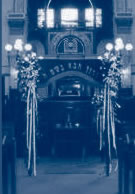|
SEDRA : Terumah Hertz Chumash p. 326 Exodus
Ch. 25
This week's Sedra is generously sponsored by Nathan Kuperholz.
SYNOPSIS:
The construction of the Sanctuary and its vessels is a dominant
theme for the rest of the book of Exodus. Its purpose will
be "and they shall make for Me a Sanctuary that I may
dwell among them " - i.e. to heighten the awareness and
closeness of the Divine Presence among the people of Israel.
The campaign to gather the funds and materials is to be a
"gift of the heart" - the attitude which should
characterise all campaigns for the maintenance of Jewish life.
The vessels to be constructed included:
The Ark of the Covenant which was fashioned from wood and
lined inside and outside with gold to house among other things,
the Testimony - the Tablets of Stone of the 10 Commandments;
The Kapporet, the top portion for the Ark fashioned from a
single solid piece of gold the upper part of which was shaped
into the Cherubim;
The Table for the Showbread symbol of G-d's sustenance of
the world; Boards, beams and columns with the necessary sockets
to build a frame for the Tabernacle;
A Parochet or partitioning curtain to separate the Holy of
Holies from the rest of the Sanctuary;
The Altars for the sacrifices and offerings together with
their utensils.
SPECIAL MAPHTIR SHABBAT SHEKALIM HERTZ CHUMASH P. 352
Exodus 30 verses 11 - 16
The Maphtir for Shabbat Shekalim is taken from the opening
section of the sedra "Ki Tissa". It introduces the
law for every Israelite over 20 years to make an annual contribution
of a half shekel towards the maintenance of the Temple and
its services as `atonement for his Soul'.
THE HAPHTORAH HERTZ CHUMASH P. 999 Ezechiel Ch. 36, verses
16 - 38
The theme of the haphtorah relates to the special maphtir
in that they both deal with the subject of purification. "How
Israel is to emerge from the grave of Exile, of undefiled
service of G-d".(Hertz)
TELL ME RABBI ... SHEMONEH ESREH (THE AMIDAH) LAWS AND
CUSTOMS
As G-d is the King of Kings, no less courtesy should be shown
to Him than to mortal Kings. The conventions of royal courts
thus became the basis of several customs during worship: for
example, three small forward steps are taken before beginning
the Shemoneh Esreh.
Where space is at a premium, the practice is to move back
several tiny steps before taking the three symbolic steps
forward. The idea that one "approaches" G-d to pray
is found several times in the Bible: "And Abraham approached"
(Gen. 18:23), "And Elijah approached" (Kings 1,
18:36).
Similarly one takes three steps backwards at the very end
of the Shemoneh Esreh before reciting the sentence, "Oseh
shalom bimromav."
While saying it, it is customary to slightly bow three times
from the waist: first towards the left, (since this is the
Sovereign's right side) then towards the right, then forward
(OH 123:1). So did a subject take leave of his king and so
do we exit from the presence of the Sovereign of the universe.
One must not permit oneself to be interrupted at any time
during the recitation of the Shemoneh Esreh even if an important
person passes by and greets you. Only the gravest emergency
justifies the interruption of one's conversation with G-d
(Berakhot 5:1).
Similarly, those entering the Synagogue during the Amidah
and Kedusha should avoid pushing past or disturbing worshippers
who are praying.
The Shemoneh Esreh is repeated at every service except at
Maariv. First it is said quietly by the congregation. It is
then repeated aloud by the Prayer Leader. (The repetition
is called hazarat ha-Shatz in Hebrew).
The public repetition of 'The Prayer' was instituted for the
benefit of those who were not able to recite it properly.
By listening attentively and answering "Amen" at
the end of each blessing, such worshipers are considered to
have fulfilled their prayer obligation (Maim. Hil. Tefilah
8:9).
The Shemoneh Esreh is not repeated at the Maariv service since
originally that service was considered optional (reshut),
and not having the same degree of obligation (hovah).
Today we treat Maariv with the same sense of duty and obligation
as Shacharit and Mincha. The non repetition remains witness
to the Talmudic ruling about Maariv's once optional character.
BACK TO SHABBAT SHALOM
TABLE
|








